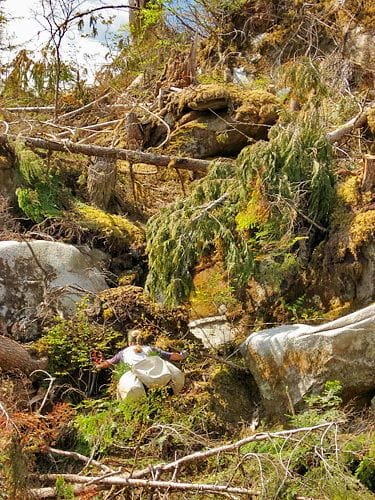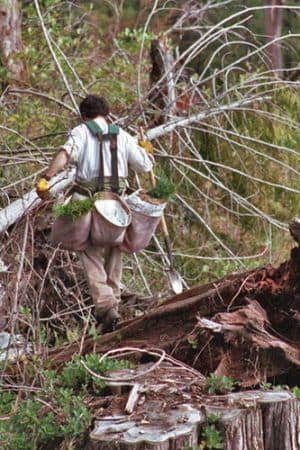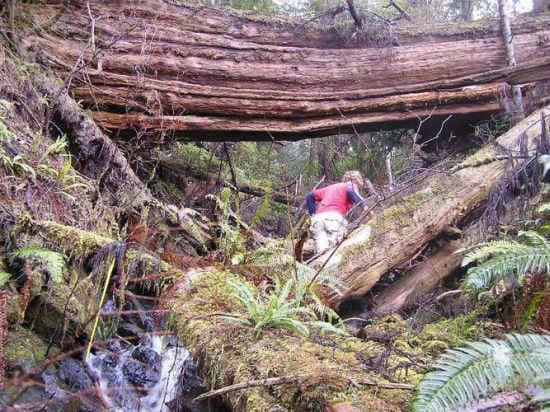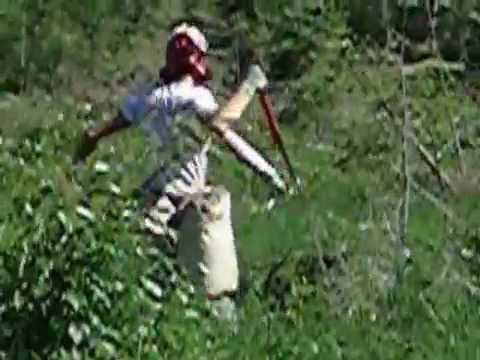One foreman kept repeating this to me: efficiency of movement. His numbers, whenever he got the opportunity to plant, were phenomenal. I watched him and he didn’t seem to be moving fast at all.
 Whenever I watched the ultra highballers, with numbers often double or more mine, they never seemed to be working harder than I. Perhaps they would spurt quicker to the next spot, but one thing I noticed is that they had that tree in the ground much faster than I did. Over the years I have discovered and picked up from others many tricks how to limit movement, and a big part of it is to choose the correct approach (depending on the soil type, conditions, and the size of the plug), and do as many of them at the same time as you can. Effectively, multi-tasking. While planting, since I cannot stop myself from analysing and thinking about things, I would often imagine mimicking the difference between a low and highballer while training other planters. I will try to explain this mimick in writing, to get the point across in a more interesting way.
Whenever I watched the ultra highballers, with numbers often double or more mine, they never seemed to be working harder than I. Perhaps they would spurt quicker to the next spot, but one thing I noticed is that they had that tree in the ground much faster than I did. Over the years I have discovered and picked up from others many tricks how to limit movement, and a big part of it is to choose the correct approach (depending on the soil type, conditions, and the size of the plug), and do as many of them at the same time as you can. Effectively, multi-tasking. While planting, since I cannot stop myself from analysing and thinking about things, I would often imagine mimicking the difference between a low and highballer while training other planters. I will try to explain this mimick in writing, to get the point across in a more interesting way.
One day I took a few minutes to watch a new lowballer on the crew. It was most amazing. He was the slowest planter I had ever seen and planted only about 230 trees a day, which after camp costs would earn him about as much as if he had worked behind the counter at McDonalds. Inevitably, he gave up after about two weeks and went back home. The few minutes I spent watching him struggle with a single tree, I saw how he would sway the shovel handle back and forth until he created a crater-sized hole large enough to plant a small rabbit in. While he made this massively large hole, he would occasionally take a break, stand up, pull out a hankerchief and wipe his brow.
Other times he might blow his nose, again. [If you want to be a fast planter, you need to learn how to snort mucous out of a nostril by closing the opposite one with one of your knuckles while moving to the next plantable spot.] Once he finished with his massive hole, he would place the plug inside, and proceed to spend another long time trying to close it up again. Other times I watch rookies and many times they are standing there scratching their heads trying to orient themselves among all their trees, wondering where they should go next. I once calculated that each second you waste during the day equals to about one penny. At such a rate, the average work day, accounting for bagups and snack breaks, would add up to 360$, which is a rough ballpark figure for a highballer.
Imagining how a lowballer might works, clambering through slash, waving my arms and battling with every branch trying to poke me in the eye. Struggling and bobbling my way to my next plantable spot, after which I would sigh with relief and take a gasp before diving down to work on creating my next hole. I would do every movement separately. In my early days I found myself standing erect, pulling out some ribbon with both hands and tying it to some branch or bush, with a double knot to make sure it would not blow away. I hope you get the picture. Contrast this with the way a highballer might do the same operation…
 With the hole successfully sealed around the plug, the highballer already has an idea which direction he/she wants to go. In fact, while planting the tree, or while approaching the present plantable spot, s/he has already scanned the surrounding area and picked out the next target. While planting I follow a general direction (the contour line of a slope, or the line of my trees I am following), which my navigation senses keep unconsciously in mind. As soon as I am done with one tree and while I am getting up, I start moving in that same direction (although I might not yet know exactly to which microspot I’m headed). If in your hurry you plant a bit far off of your trees, simply plant your next tree a little closer to compensate (the correct number of trees in your plot should work out). While in the motion of moving towards my next spot, my left hand whizzes up to the ribbon which had been dandling loosely, at a specific height from my left pouch and in near proximity to the tree I had just planted. (Heck, never tried it but you could even consider taping a razor blade on your bag in a certain location to help rip off a slice of ribbon with only one hand.)
With the hole successfully sealed around the plug, the highballer already has an idea which direction he/she wants to go. In fact, while planting the tree, or while approaching the present plantable spot, s/he has already scanned the surrounding area and picked out the next target. While planting I follow a general direction (the contour line of a slope, or the line of my trees I am following), which my navigation senses keep unconsciously in mind. As soon as I am done with one tree and while I am getting up, I start moving in that same direction (although I might not yet know exactly to which microspot I’m headed). If in your hurry you plant a bit far off of your trees, simply plant your next tree a little closer to compensate (the correct number of trees in your plot should work out). While in the motion of moving towards my next spot, my left hand whizzes up to the ribbon which had been dandling loosely, at a specific height from my left pouch and in near proximity to the tree I had just planted. (Heck, never tried it but you could even consider taping a razor blade on your bag in a certain location to help rip off a slice of ribbon with only one hand.)
My right hand uses the shovel as a crutch to help me rise up as my left hand pulls the ribbon towards my right hand. I loop the ribbon around my right thumb, naturally located on the left part of the handle. Once at a specific length, I let go of the ribbon from my left hand to regrab it closer to where my thumb is pinning it to the shovel handle, rip it off and place it somewhere on the ground. This all I have accomplished before taking my first step. While taking my first step, I notice a small bush in my way, so I let my foot fall on the stem of it, as such removing it from my way with minimum effort.

But most of the time I ninja my way through the jungle, with minimum resistance against nature, slithering through the quagmire to get to my next spot with one or two slinky and carefully targetted steps. While on the way I have found plenty of time to raise the knuckle of my right hand to my nose, close one nozzle and snort out some boogers from the other. No time for kleenex and I’ll save the other nostrel for the next tree, if I can’t squeeze it in during this one. While approaching and slinking my way to my next spot, my left hand is already fumbling in my bag for the next tree, my right hand slowly raising the shovel, poised and moving gracefully in the air in anticipation of lunging into my next plantable spot. My assessment of the terrain is, once again, correct, and the shovel glides effortlessly into the soil, which I anticipated under that small patch of specifically coloured moss.
It doesn’t matter how tough and intimidating the ground may look, you just overcome and DO it. Look at the efficiency of movement of these two fast planters at the end of this video:
Otherwise, if I am on some clayey or rocky ground and anticipate there could be a struggle getting the shovel in quickly, my last step is directly over the heels of the shovel kicker. My other foot has already been placed in a position which would help me balance while I use my left leg to nudge the shovel into the ground. While I open the hole with one or as few movements as possible, the left hand is already swooping in towards the hole, with tree in hand. It is a natural movement from one tree to the next, multitasking as many movements as possible. It is a smooth, ninja-style flow, working best if you develop a sense of rhythm. It even looks magical and effortless, as shown by this ultra highballer in the above video, who would get around 5000 trees a day in crazy jungly ground.

Julia treeplanting: “I’m not special. If I can do it [plant 5,000 trees a day], you can too.”
The doubling-up of tasks and the minimising of movements is probably the first thing you’ll learn. Where exactly to plant the next tree is a much more difficult problem and, as a rookie, you will often find yourself standing there, staring around, dumbfounded and wondering which direction to go. If you get into the unconscious navigation mode (which general direction you should be headed, even if you’ve had to turn around to get a better angle at a microspot), you are able to earmark your next plantable spot while moving forward. I may use the treeline or edge of the block as a navigational guide, moving in parallel along it, first in one direction and then the next once I head back.

You learn to read the ground quickly and know roughly where the next, best spot will be. Choice of spot is very important, because a poorly chosen spot, such as one full of rocks, or in a rotten log, or among roots, will slow you down considerably. A rookie tree planter will often find himself banging around with the shovel, using it as a probe to find nice, soft soil. Not finding the best place, he may spend much longer struggling with roots etc. Like a hawk picking out its prey from high up, a veteran planter can scan and assess the immediate terrain within one or two seconds and already know exactly where to plunge the shovel. We can refer to the ideal microspot within an immediate terrain as the “creamy spot“.
Unfortunately, we do not always live in a world of cotton candy and creamy soil. It can be a harsh and selfish world, full of brambles, thorns, lying trees and massive stumps. Therefore, rarely might we be able to plant in straight lines of tight spacing. Especially if we are near the coast, where the width of discarded trees can be as tall trucks, their stumps consuming a lot of space, and the slope of the hill making such line planting with forced clambering over obstacles outright absurd. This type of terrain is more suitable for “area planting”. Where you zig zag your way AROUND all the obstacles, preferably along the horizontal contour of a slope, and apply your minimum spacing by planting in small steps through a complex maze. Try to avoid stepping over big logs, almost never struggle to get to your next plantable spot, and always with minimum spacing.
 This spatial maze winding is also rather difficult and takes time to perfect. Many times the obstacle can be superfluous. A small dying tree melting into the surrounding moss. But your seedling might be so small you can barely see it without the use of ribbon. In such cases and to avoid excessive use of ribboning, you can consider a rotting log as part of a boundary for a mini area, which you fill in by planting trees along its edge, then pound a necessary few in the center to reach your plot quota. While planting your way back in the opposite direction, you might notice one of your trees behind a log, perhaps you have left a small ribbon in the mini area, or perhaps you might even remember that same log or mini area, and space off the log/boundary, being confident that any “area” behind it has already been filled.
This spatial maze winding is also rather difficult and takes time to perfect. Many times the obstacle can be superfluous. A small dying tree melting into the surrounding moss. But your seedling might be so small you can barely see it without the use of ribbon. In such cases and to avoid excessive use of ribboning, you can consider a rotting log as part of a boundary for a mini area, which you fill in by planting trees along its edge, then pound a necessary few in the center to reach your plot quota. While planting your way back in the opposite direction, you might notice one of your trees behind a log, perhaps you have left a small ribbon in the mini area, or perhaps you might even remember that same log or mini area, and space off the log/boundary, being confident that any “area” behind it has already been filled.
In this way you should start to get an idea how a highballer minimises every move possible – from the amount of times s/he drops a ribbon, to how many steps to take between trees, to the amount of slash they have to clamber over or struggle through, to the doubling of tasks during the entire process.

Next: |
We are a family operation managing private custom boat tours in the beautiful Palawan area, and are happy to help travelers with their plans through the country, having traveled a lot of it ourselves and planning to visit it all. The pages in this section concern when I was treeplanting in Canada over eight summers.
